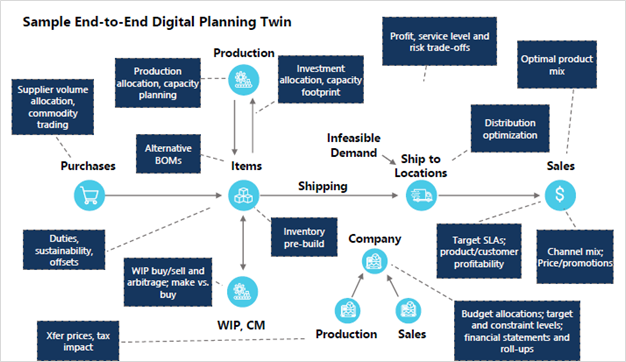Business Continuity Planning (BCP) is, in essence, an organization’s readiness and capability to continue meeting its objectives and demands at acceptable levels when disruptions arise. Today, two issues are compelling leaders to reexamine how they tackle BCP in their organizations: 1) Disruptions have become more intense and frequent, and 2) Significant limitations in traditional BCP approaches are rearing their ugly heads. The good news is that when done well, Business Continuity Planning not only increases resiliency but also generates a strong ROI that in most cases exceeds 10x.
Challenges Facing Business Continuity Planning Practitioners
BCP leaders and teams are tasked with examining all functions and potential impacts to best balance tradeoffs between different objectives via policy and strategic decisions. Several elements are combining to make this task more challenging than ever, including:
- Supply chains that are designed for efficiency (but not resiliency and agility)
- Changing customer expectations re: product makeup, origin, delivery, and experiences
- Expanding and sometimes competing priorities (e.g., ESG, risk, community), and
- Unprecedented disruption levels (pandemic, climate change, geopolitics, regulatory constraints)
BCP practitioners also need active contributions from multiple groups – supply chain, manufacturing, procurement, finance, strategy, risk, and others. The totality of these variables and the stakes involved make it critical for organizations to get BCP right.
Common BCP Approaches and Where They Fall Short
Traditionally, businesses have applied a broad spectrum of approaches and tools for BCP. The problem is that generally speaking, most of these approaches and tools were built either for a particular challenge or narrow set of issues or do not have the power to deliver BCP leaders the information they need as fast as they need it. This includes:
- Excel – While ubiquitous and intuitive, Excel is not geared for BCP complexity or to provide meaningful recommendations.
- Customized Optimization Tools – These tools typically come with exorbitant costs, require PhDs years to implement, and lack agility and a good user experience that drives adoption.
- Control Tower Tools – While helpful for supply chain response, Control Tower tools don’t enable full assessment and redesign of the value chain.
- Financial Planning Software – Organizations need to look beyond just financial impacts and variables to assess the full array of current and potential business constraints.
- Network Design Solutions – These high-level, supply-chain-centric tools are unable to examine strategy and policy decision tradeoffs across the value chain.
- XP&A Solutions – Extended Planning and Analysis tools force a sequential approach of tactical problems which causes slowdowns and resource drains.
- S&OP/IBP Solutions – These tools are useful for optimizing tactical policies, but not strategic initiatives or commercial supplier arrangements.
Applying a Digital Planning Twin to Drive BCP
A Digital Planning Twin provides BCP practitioners with a true representation of how the business delivers products and services, including demand, customer terms, the value chain, revenue, costs, and financial statements. It then applies optimization to recommend the best decisions, subject to the restrictions and objectives specified.

Specifically, a Digital Planning Twin supports BCP by:
- Identifying the plan(s) that best meet objectives, simultaneously aligning strategic and tactical decisions about demand, product, capacity, procurement, and financials.
- Generating an optimized roadmap for investments and new capabilities, including quantified value capture potential.
- Understanding key constraints and performance drivers (e.g., What’s the marginal value of an hour of capacity? What would it cost to move resiliency from 90% to 95%?)
- Providing an integrated set of reports that include the “whys” underlying recommendations and identifying actions that generate limited value
- Carrying out extensive and simultaneous what-if scenarios, testing for resiliency, and quantifying key trade-offs
These supports enable planning under uncertainty in a safe environment that gives leaders a holistic view of policy and decision impacts and quantified reaction paths to unplanned disruptions.

Advanced and Accelerated Decision-Making
Because the intensity and frequency of disruptions have increased, organizations need a faster and more dynamic approach to simulate scenarios and disruptions. They cannot afford to devote BCP teams and analysts for weeks at a time on a small set of parameters. A Digital Planning Twin that’s supported by advanced decision making dramatically reduces solve time and readies new studies quickly, delivering plans and recommendations with detail that connects directly to execution. Key numbers that leaders should keep in mind in considering a Digital Planning Twin to power their BCP efforts include:
- Typical Impact – 10-15% NPV improvement
- Resiliency – Up to 30% increase
- Agility – 80% faster to plan, 65% less effort, 95% fewer spreadsheets
- Implementation Time – 3-6 months
- ROI: >10x
Resources involved (part-time) in implementing a Digital Planning Twin for BCP should include BCP leadership, strategy, finance, procurement, and IT. Their work is supported and strengthened by digitizing the physical, commercial, financial, and managerial realities of the enterprise to fully align and support high-quality decision-making. Outputs are GAAP Compliant and meet CFO and P&L leader needs.
The Increasing Importance of Business Continuity Planning
The realities of the current and foreseeable operating environment make getting BCP right more important than ever for organizations. Traditional tools and approaches to BCP are no longer sufficient if businesses want to ensure their ability to absorb shocks and continue to meet objectives and market demands. Applying the power of a Digital Planning Twin to BCP enables leaders to answer complex questions quickly and turn insights into actions.
To learn more about strengthening Business Continuity Planning with Digital Twin, get in touch with us today.






